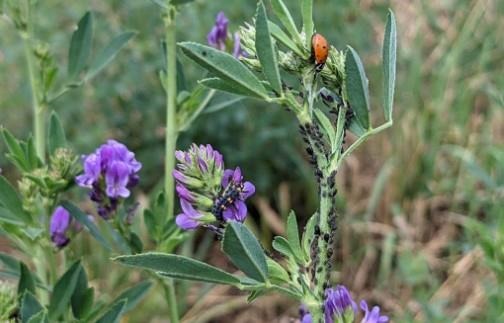Identification
Cowpea aphids vary in color based on their life stage. Nymphs tend to be a dull, dark gray, while adults are a shiny black color (Figure 2). Both nymphs and adults have tan-colored legs with darker tips (feet), tan antennae and black cornicles (tailpipes). The adults are approximately 1/8th of an inch long.

Figure 2. Cowpea aphid colony.
Scouting and Management
Generally, cowpea aphid populations are not much of a problem, though it is common to see population growth after the application of insecticides for a different insect pest like alfalfa weevils. To stay ahead of cowpea aphid populations, alfalfa should be scouted on a weekly basis throughout the season to ensure that populations do not exceed the recommended thresholds (Table 1). To scout for aphids in alfalfa, either a sweep net or direct stem counts can be used.
If using a sweep net to sample, conduct 30 pendulum swings for each leg of a “W” or “Z” pattern while walking in the field. Count the number of each species present after every 30 swings and calculate averages. Repeat this process in additional areas of the field to determine field infestation levels.
If using the direct stem counts, collect a total of 30 stems while also walking in a “W” or “Z” pattern. For each stem, carefully cut it near the soil surface, and shake it into a white bucket, then count the total number of aphids per stem and calculate an average for the field.
TABLE 1. ECONOMIC THRESHOLDS FOR AVERAGE COWPEA APHIDS
IN ALFALFA PER 30 SWEEPS OR 30 STEMS.
| | Average Number of Cowpea Aphids Found |
|---|
| Growth Stage | Sweep | Stem |
| Seedling | -- | 5 |
| Less than 10” tall | 300 | 40 |
| More than 10” tall | 400 | 75 |
No matter which method you use, while walking through the field, pay attention to the presence and abundance of natural enemy species. If numerous natural enemies are also collected in the sweep net, or observed while walking, insecticide management may not be necessary depending on the aphid populations. In the alfalfa that we scouted, the populations greatly exceeded an average of 400 aphids and numerous natural enemies were present. Even though the natural enemies will feed on numerous aphids, the aphid population will still increase and will need to be managed using a foliar insecticide.
If thresholds are exceeded, a list of insecticides that are currently labeled for aphid management in alfalfa can be found in the latest South Dakota Pest Management Guide: Alfalfa and Oilseeds.
Source : sdstate.edu